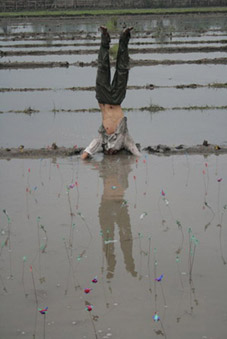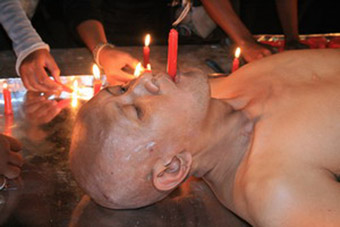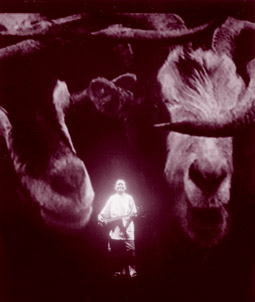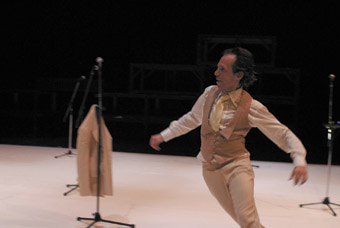Jan Cornall at Perfurbance#3, Yogyakarta, Java
 | I Gede Made Surya Darma (Indonesia - Bali) photo Dolly |
Organisers: The Performance Klub, a group of local artists committed to bringing art out of conventional art spaces into public places. They have developed a close relationship with the people of Gemblangan since carrying out volunteer relief work there.
Performance Map: The tiny village is a circular island surrounded on all sides by rice paddies. A path follows the small river (irrigation channel) around the perimeter of the circle. Only two roads cross in the centre of the village. The mosque and cemetery guard the back road into the village. The Jamu House (jamu is a traditional medicinal drink) stands at the main entrance. (This village is also famous for cobra-snake medicine). Rebuild-ing is going on all around but many families are still living in the ruins of their old houses in bamboo shacks provided by aid organizations.
Program: Artist performances, traditional local performances, seminars on organic farming, recycling, first aid, cultural and spiritual values, an excursion to Borobodur Buddhist temple, a dangdut concert finale (popular sexy Indo-Arabic music).
Village Hosts: House and feed over sixty artists and volunteers for five days. Mr Gyanto (Mr Jamu) is the main mover and shaker. Plus the women’s food collective, security, other volunteers, billets.
 | W. Christiawan (Indonesia - Bandung) photo Dolly |
day 1
11am. Traditional Welcome:Local dignitaries including Bantul Regent, Mr Idam Samawi and guests arrive. Villagers in traditional dress line the roads. Village men sing and play traditional Islamic songs. Mr Samawi gives a passionate speech - Bantul says no to malls and globalisation!. Visiting artists are brought to teh stage and given plain coloured flags to use in their performances
1pm. Traditional Performance: Jathilan—young boys in gaudy costume, makeup and riding toy horses perform traditional trance dances that go on for several hours. The whole village attends. The trance master is particularly fascinating. One of the international artists accidentally goes into trance. The trance master is called away to assist. A crowd follows. She recovers, with a bad headache.5pm. Location Meeting: Artists decide on location and time of performance. Volunteers draw up map and timetable.
9pm Gejong Lesung: Traditional music shows about the history of the land by women from a neighbouring village.
Day 2
11am. Seminar: Importance of cultural and spiritual values in maintaining independence/autonomy in a global world. The head of local Islamic boarding school, Mr Djawis, a former Minister for Culture, Mr Marzuki and myself discuss spirituality, tourism, economics and performance.3pm: Art Performances begin. Lewis Gesner, USA, 2 hours, all around the village. Arrives with a ball of string and a pair of scissors, walks, collects objects, ties them to string, ties other end to his leg, walks slowly again, collecting and dragging objects behind him.
3.20pm. Maya Pasternak, Canada/Tel Aviv, video interviews with villagers as they work, continuous over 3 days. Begins in southeast part of the village.
3.45pm. I Gede Made Surya Darma, Bali, walks into the fallow rice paddy near Jamu house carrying bunches of plastic flowers. On closer examination we see they are small toy soldiers, tanks and planes on long stalks. He plants each stalk slowly and methodically in lines. After a while others wade into the water to help. When all are planted he “plants” himself by standing on his head on the paddy bank.
4.10pm. Harumi Tereo, Japan, south end of village, places coloured squares of paper on the low wall next to irrigation channel. Rearranges them, using only her toes. Lies down on them and performs “a feet, arms and hand dance”, changing position from front to back and side to side.
4.30pm. Mayumi Ishino, Japan/New York, on the west side of the village in the cow and sheep corral. Draws a self-portrait on a mirror hung on a tree trunk. Animals baa and moaaah in chorus. When she has finished the portrait she takes out a hammer and smashes it. Then walks away with it under her arm. She repeats this every day in different locations with a finale of four or five in a row in a central location near the kitchen.
4.50pm. Bruno Mercet, France, next to a villager’s house on south west corner. Bruno wears only his flag around his waist. It doesn’t quite cover all of him. Organisers go into a slight flurry. It’s not kosher to be naked in a Muslim village. But no one is bothered. He’s a westerner after all. He plays with an old door, climbing in and around and through it then writes a greeting to his host on the top of the door. His host, a tiny old lady, laughs a toothless smile.
5.00pm. Huang Ming Chi (Mickey), Taiwan, at a house near the crossroad gives a massage to a village woman. She waits at the door telling the audience she won’t start until exactly 5pm. She sets her timer and leaves it outside the house. She enters, gives the massage for allotted time and leaves when timer goes off. She does an activity like this each day with a villager; helps in rice fields and in the collective kitchen.
And So On Into The Night, followed at 9pm by a Dzikir Saman—a religious show of song and dance.
Days 3, 4, Continue As Above: same daily schedule with works from other international and local performance artists: China—ShaoYan Xin, Qing Sheng Ming, Wang Jian; Surabaya—Illham J, Bidai, Aye Ko; Jakarta—Santo Clingon; Bali—I Kadek Dedy Sumantra Yasa; Japan—Shinya Misawa, Seiji Shimoda, Makoto Maruyama, Sakiko Yamaoka, Yoshie Baba; Yogyakarta—Sindu Cutter, Emilia White, Bocor Alus Group, Buyung Mentari, Ronald Apriyan, Lepan, Rachel Saraswati, Yudha Coklat, Iwan Wijono, Arahmaiani; Australia—Patrick O’Brien, Jan Cornall; Bandung—Ferial Affif, Isa Perkasa, Deden Sambas, W Christiawan; Singapore—Lee Wen, Jeremy Hiah, Kai Lam, Agnes Yit; Solo—Choiri, Satriana Didik, Ozy; Myanmar—Aye Ko.
Audience Response: Many of the villagers are quick to engage with the performances—joining in and helping out with props and logistics. Audience from Yogyakarta come and go—more there in the evenings. A moving feast of press and avid documenters follow like a paparazzi pack.
day 4
An Unexpected Performance Event. On Day 3 an elderly lady of the village dies. We go to pay our respects. On Day 4, prayers are sung across the village all morning. Masses of people arrive from other villages. We are invited to take part in the funeral procession. Lewis and Bruno help carry the coffin and myself, Mickey, Agnes and Maya, with young village women, carry flower petals, flower water, stakes and banana leaf parcels to the grave side.
day 5
Excursions to Borobodur and Parangtritis Beach
2pm. Final Session. Villagers and artists agree it has been a valuable and unforgettable experience. Visiting artists thank their hosts and promise to return.
5pm. Performance by Sangar Rumah Kardus & Andi O. Earthquake Victims Kids Group.
9pm. Dangdut Concert Finale. Draws an audience from surrounding villages. Westerners learn some sexy moves from the Dangdut Divas. Retire to the Green Room (Jamu House) when they can dance no more and see in the dawn over the rice paddies before catching flights home.
post festival
In an email a few days later from the USA, Lewis Gesner summed it up beautifully. “Placing performance art in a cultural setting of traditional music and dance and a physical setting of a village on the cusp of globalisation was a brilliant construction...for moving forward positively as people and neighbours in a world that is becoming an increasingly smaller village, for better, or worse. Perfurbance#3 pointed to a better village, and hurray for that!”
Perfurbance #3, Yogyakarta, Indonesia, April 25-29
RealTime issue #79 June-July 2007 pg. 14
Realtime arts is a print and online arts magazine:
www.realtimearts.net
Perfurbance Performance Art Festival is ongoing:
http://perfurbance3.blogspot.com/
Jan has taken part in Perfurbance #2, # 3,#4 and Open Arts Festival in Beijing in 2009
and continues to support the Performance Klub.
www.jancornall.com










